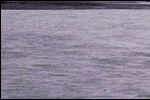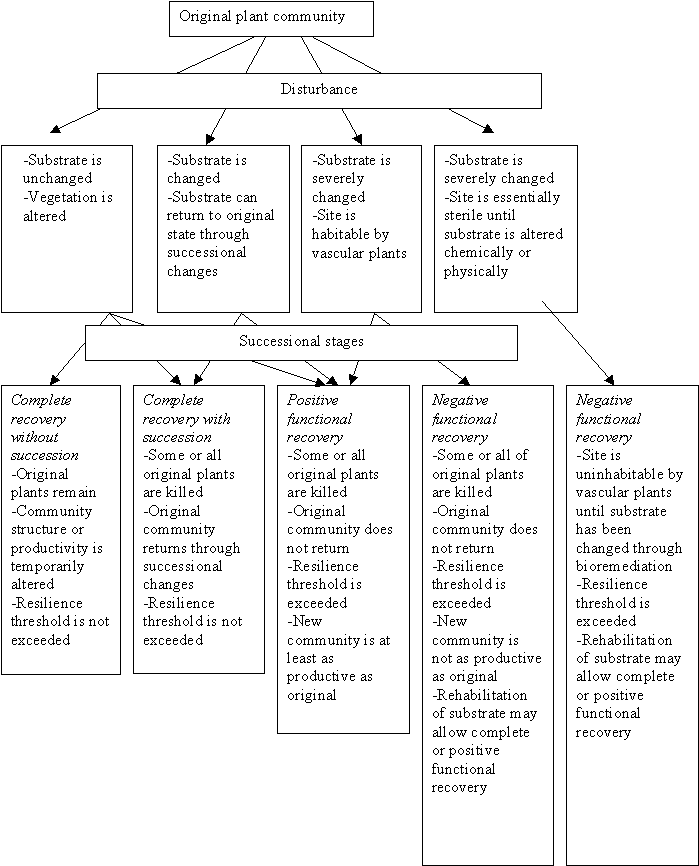
| Home
Mission 2007 Team Research Sources Progress Journal |
|
Research Disturbance ¡V ¡¥disturbance is a change to the
minimal structure(of a system] caused by a factor external to
the level of interest¡¦
Ecosystem spatial pattern at all scales is the
¡¥system¡¦ Minimal
structure ¡V pattern of plant species at the plot level, plant
communities at the site level, or physiognomy and production at
the regional level. ¡§The dynamic character of terrestrial ecosystems is
a function of natural disturbance regimes operating over a
broad range of spatial and temporal scales.
Analysis of human-caused (anthropogenic) impacts in
tundra ecosystems requires a means to compare the effects of
these disturbances with natural ones. The distinction between natural and anthropogenic
disturbances is made in order to clearly separate those that
were part of the landscape before the appearance of man from
hose that are the result of man¡¦s activities.
Most anthropogenic disturbances have natural analogues,
but the scale or extent of the analogues may be radically
different. In fact,
natural and anthropogenic disturbances differ most in magnitude
of energy input because in most cases man and Nature are dealing
with the same materials. Important
aspects of disturbance and recovery in permafrost regions
The physical system
Ice-rich permafrost is a major factor controlling
disturbance and recovery in the Arctic.
If the permafrost thaws, thermokarst can be initiated on
a large scale, and a critical point is reached where it is
difficult or impossible to return the site to its original state
within a few decades because of continued subsidence
Thawing of ice causes:
i)
hydrologic
changes(impoundment of water or creation of flowing water
ii)
thermal
changes by decreasing the albedo of the surface and increasing
heat flux to the site
iii)
geochemical
changes(usually increased nutrient availability)
Attributes that contribute to thermokarst:
i)
volume
of ground ice in the near surface sediments,
ii)
steepness
of the terrain
iii)
grain
size of the sediments à
disturbance in areas with high amounts of ice, rolling
topography, and fine-grained sediments may not stabilize even 30
years after the disturbance à
how these factors are affected by
drilling will be related to what the parameters are
How to determine these attributes:
grain size and steepness can be determined from
surficial geology maps and digital terrain models(DTMs)
Modification
of the site following disturbance: ¡§if heat flux to ice-rich terrain is increased by
any of a variety of means, such as changes in surface albedo,
hydrologic conditions, thermal conductivity of the active layer,
snow regime, or local sources of heat(eg.
From drilling machinery?) thermokarst is likely the
result. The control
on heat flux are complex. The
radiation balance and thermal properties of the soil are
affected by position, depth of the moss carpet, bulk density of
the soil, vegetation cover, snow cover, and moisture regimes.
Deep organic layers and thick moss carpets are good
insulators against heat flux unless the organic material is
saturated, as is often the case in low microsites.
Physically based models of heat flux now offer
predictions of changes to annual thaw depth in response to
climate change.. The
thermal stability of the site constrains the time required for
vegetation recovery ad the type of vegetation that will reoccupy
the site. Perhaps
nowhere on earth is the synergistic link between physical
stability of the substrate and vegetation recovery more evident
than in permafrost regions (Walker 1991).
¡@>>>>>>>>>>>>>>>>>>>>>>
Some ideas we had on 11/18 at 3am....
Parameters: We are considering the following aspects
of the environment and oil drilling impact as parameters for environmental
impact and threshold limit: Degree of destruction depends not only
on the intensity and kind of disruption but upon the kinds of
vegetation, soil, permafrost and animal life that were
there. What mainly affects vegetational re-establishment
difficulty were soil destruction -by compacting, and by melting
of the underlying permafrost Factors: Vegetation --> characteristics to consider -distribution of vegetation types - snowcover - plant biomass - nutrient and fiber content - phenology others: - permafrost thaw depths * in 1970 Ives established a formula relating fragility of tundra to destruction and physical factors. He suggested that fragility of tundra to destruction is directly proportional to the ice content of hte permafrost and inversely proportional to the mean ground temperature. F µ i / tg F: tundra fragility, i: percentage ice content of the permafrost, tg mean annual ground temperature
notes: Cannot bear
high pressure (quantitative?) Excessive
water not necessarily good (small plants may drown) ¡Vroadside
flooding. If permafrost thaws, will promote higher plants like
willows. Temp
affects microbiological processes (0-10 degrees celcius, do
better, then more nutrients). Plants will
die under the platforms area, sunlight gone. Some plants
insulate permafrost, forming organic mat, helping other plants
to grow. ¡§The
impact from seismic vehicles and lines depends on the type of
vegetation, texture, and ice content of the soil, the surface
shape, snow depth, and type of vehicle¡¨ (arctic.fws.gov/issues1.html) Snowcover: - 'measurable, low-level disturbance occurs at depths of as much as 45 cm in tussock tundra, and 72 cm in sedge-shrub tundra. Moderate disturbance occurs at snow depths to 25 cm in tussock tundra and 35 cm in moist sedge-shrub tundra ¡@Permafrost Mosses-lichens
(insulate): Permafrost underneath destroyed. Thaw
depths 7-12 cm greater in disturbed plots (¡§Response of arctic
tundra plant communities to winter vehicle disturbance¡¨) Overall
digging etc will melt permafrost, affecting plant growth in the
area. ¡§If
permafrost thaws, thermokarst can be initiated on a large scale,
and a critical point is reached where it is difficult or
impossible to return the site to its original state within a few
decades because of continued subsidence.¡¨ (Walker) -The
thawing of ground ice causes hydrologic changes due to the
impoundment of water or creation of flowing water. -Thermal
changes by decreasing the albedo of the surface and increasing
heat flux to the site. -Geochemical
changes, usually in the form of increased availability of
nutrients. ¡§Three
major attributes of the physical system contribute to
thermokarst in permafrost regions: -volume
of ground-ice in the near surface sediments -steepness
of the terrain -grain
size of the sediments Disturbance
in areas with high amounts of ground ice, rolling topography,
and fine-grained sediments may not stabilize even 30 years after
the disturbance. The grain-size and steepness ¡Vsurficial
geology maps and digital terrain models¡K volume of ground
ice.¡¨ ¡§The
controls on heat flux are complex: the radiation balance and
thermal properties of the soil are affected by topographic
position (slope and aspect), depth of the moss carpet, bulk
density of the soil, vegetation cover, snow cover, and moisture
regimes¡K The thermal stability of the site constrains the time
required for vegetation recover and the type of vegetation that
will reoccupy the site.¡¨ ¡@ ¡@ |



¡@
| Last updated: Dec 1, 2003 | Team 5 - m2007-5@mit.edu |
